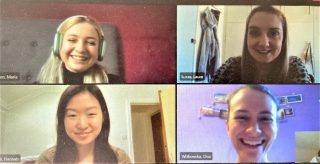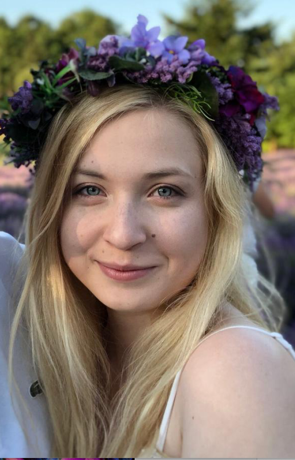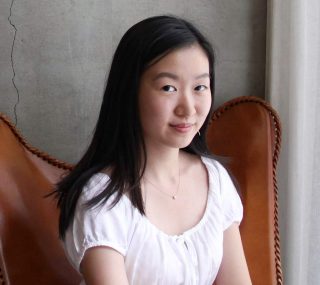Can you tell me the story?
Here in the LiLaC lab, we love to develop researchers of the future by providing  opportunities for current UCL students to join the Lab, learn what it’s like to be part of a research team, and gain hands-on experience working with research data. This term, we have been joined (albeit virtually) by two wonderful second year undergraduate students, Hannah and Maria! Here they discuss what they have learnt from the experience…
opportunities for current UCL students to join the Lab, learn what it’s like to be part of a research team, and gain hands-on experience working with research data. This term, we have been joined (albeit virtually) by two wonderful second year undergraduate students, Hannah and Maria! Here they discuss what they have learnt from the experience…
About the project:
PhD student Disa Witkowska is investigating children’s abilities to retell a story, also known as narrative recall. Disa is specifically interested in whether there is any difference in the grammatical complexity of narratives recalled by monolingual English speaking children and their bilingual peers.
The narratives for this project come from the Surrey Communication and Language in Education Study (SCALES). Children listened to a story about a monkey and a parrot whilst being presented with visual representations of the story. The children were then shown the images again, and asked to retell the story to the researcher (ACE-Recall; Adams et al, 2001).
Disa and Laura (Research Assistant on the LiLaC team) have developed a new narrative coding scheme based on previous research by Frizelle et al. (2018) to assess the grammatical complexity of each child’s story. We have data from each child at two timepoints: Year 1 (age 5/6) and Year 3 (age 7/8). We are coding the narratives for number of and types of clause, number of grammatical errors (e.g. wrong verb tense or missing subject), and use of verbs. Previous research has suggested that as children get older, they increase productivity (their recall becomes longer and more detailed), including more frequent usage of clauses, a greater variety of clause structures and greater syntactic complexity (Justice et al., 2006; Mäkinen et al., 2014).
Hannah and Maria have coded a whopping 240 narratives during their 12-week internship!
Over to you Disa to analyse this amazing dataset…!
 My name is Maria and I’m an undergraduate student here at UCL, doing a degree in Psychology and Language Sciences. My primary interests are in experimental and clinical psychology, in particular topics surrounding mental health and the neuroscience of language and emotional processing.
My name is Maria and I’m an undergraduate student here at UCL, doing a degree in Psychology and Language Sciences. My primary interests are in experimental and clinical psychology, in particular topics surrounding mental health and the neuroscience of language and emotional processing.
I joined the LiLaC lab in January to work on narrative interview coding and have greatly enjoyed being part of the team! The placement was a thrilling opportunity to be involved with current research and apply the knowledge from my degree programme to a real-life scientific setting. Besides the topic of research closely matching my interests, I was particularly drawn by the practical, hands-on component and the possibility of joining the team in paper presentations and discussions, all of which are extremely valuable experiences for undergraduates pursuing research, such as myself.
As well as the invaluable practical skills I’ve picked up at the lab, including applied knowledge of linguistics and narrative coding, I have also learned a lot about research as a career. Because of the plethora of different research projects and areas of interest the members of the lab are involved in, I was able to explore various topics and observe (and even take part in!) the development of fascinating publications and interventions. The supportive, collaborative and intellectually stimulating atmosphere of the LiLaC lab has further motivated me to work toward a career in research. I hope to be able to join the lab again in the summer to develop my own research project about the impact of the Covid-19 pandemic on the mental health of children.
 Hannah: Before I started my twelve-week placement in the LiLaC Lab, I was interested in the prospect of a career in research, but I had never had the opportunity to have hands-on experience of being involved in a research project. I was apprehensive, but excited about what it may involve!
Hannah: Before I started my twelve-week placement in the LiLaC Lab, I was interested in the prospect of a career in research, but I had never had the opportunity to have hands-on experience of being involved in a research project. I was apprehensive, but excited about what it may involve!
Once the SCALES research team welcomed me into the group, I was encouraged by how rewarding research is. The hours of meticulously inspecting, analysing, and coding narrative language samples were long, but I enjoyed every bit of it. Each week, I learned more about the different facets of research through our weekly lab meetings, where we discussed our findings and presented empirical papers.
I felt like an equal among a group of professors and academics, and this intellectually stimulating yet comforting environment has propelled my interest in a career within research. To further pursue this, I am applying to summer internships in the hope of gaining more knowledge and experience. I am specifically interested in studying more about the links between socioemotional cognition and language development in children.
As my time with the LiLaC team draws to a close, I would like to thank everyone who has helped me take such a pivotal step forward in my educational growth: Laura and Disa, for taking the time to train and assist Maria and me. Prof Courtenay Norbury, as well, for guiding us through the research process and for giving us the chance to work with such knowledgeable scholars in this field.
References
- Adams, C., Coke, R., Crutchley, A., Hesketh, A. and Reeves, D. (2001) Assessment of Comprehension and Expression 6 – 11. NFER-Nelson, London. ISBN 9780708705612
- Frizelle, P., Thompson, P., McDonald, D., & Bishop, D. (2018). Growth in syntactic complexity between four years and adulthood: Evidence from a narrative task. Journal of Child Language, 45(5), 1174-1197. doi:10.1017/S0305000918000144
- Justice, L. M., Bowles, R. P., Kaderavek, J. N., Ukrainetz, T. A., Eisenberg, S. L., & Gillam, R. B. (2006). The index of narrative microstructure: A clinical tool for analyzing school-age children’s narrative performances. American Journal of Speech-Language Pathology, 15(2), 177-191. https://doi:10.1044/1058-0360(2006/017)
- Makinen, L., Loukusa, S., Nieminen, L., Leinonen, E. & Kunnari, S. (2014). The development of narrative productivity, syntactic complexity, referential cohesion and event content in four- to eight-year-old Finnish children. First Language, 34 (1), 24-42. http://dx.doi.org/10.1177/0142723713511000